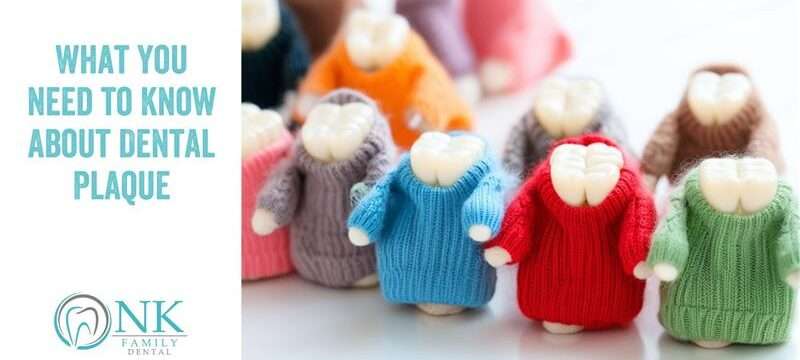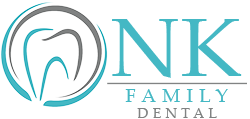
TV commercials for toothpaste and mouthwash promote the effectiveness of their particular brand at combatting plaque. Although you hear about plaque a lot, you still may not know exactly what it is — or just how serious a risk it is to your oral health! Keep reading to learn what dental plaque is, the process that leads to plaque hardening into tartar and the steps you can take to fight it in order to maintain a healthy smile!
What Exactly is Dental Plaque?
Scientifically speaking, dental plaque is a biofilm — a colorless layer of bacteria buildup on the teeth. When we eat foods full of carbohydrates, the bacteria in our mouth feed on those carbohydrates and produce acids. Should you think this is a slow process, the bacteria in dental plaque are constantly reproducing. In less than 24 hours, the plaque can build up to the point where it becomes noticeable.
Plaque is colorless, but can sometimes cause tooth discoloration because food particles stick to the plaque. According to Cleveland Clinic, “Dental plaque makes your teeth look (and feel) ‘fuzzy.’ If you run your tongue over your teeth and it feels like they’re wearing tiny sweaters, that’s plaque.”
Consequences of Plaque Buildup Hardening to Tartar
Should you allow plaque to build to the point where it’s visible as a yellowish coating around the edges of the teeth near the gums — or you get the tiny sweater feeling — the next stage is plaque hardening to tartar — also known as dental calculus. Tartar gradually forms as plaque absorbs minerals from your saliva. It forms more slowly than plaque, occurring at, underneath and above the gumline.
Unlike plaque — which can be removed with regular oral hygiene practices, such as brushing, flossing and professional cleanings during your six-month dental examinations — tartar can only be removed with a professional cleaning by your dental hygienist. In the case of heavy tartar buildup, a deep cleaning may be necessary. Also known as scaling and root planing (SRP), this procedure involves the hygienist cleaning deep into the gumline and root surface to remove tartar. Deep cleaning is also the first step in treating gingivitis, which is probably already occurring.
If not removed, tartar can lead to the following oral health issues:
Cavities — Dental tartar causes cavities by creating a rough surface that traps bacteria, which then produce acids that eat away at tooth enamel. Because tartar is a hard, mineralized deposit that cannot be removed by brushing, it provides a permanent hiding place for these cavity-causing bacteria. This leads to continuous acid production that erodes the tooth, forming small holes that eventually become cavities.
Periodontal (gum) disease — The same process that leads tartar to cause cavities also comes into play for periodontal disease. In this case, tartar provides a rough, porous surface that makes teeth even harder to clean and attracts more plaque to adhere to it. The bacteria in plaque and tartar irritate the gums, causing gingivitis — the first stage of gum disease. Gums become red, swollen, and may bleed easily.
If left untreated, the inflammation continues and spreads below the gumline, resulting in periodontitis. The body’s response to the infection damages the soft tissue and bone that anchor the teeth. This can form deep pockets between the teeth and gums filled with plaque and bacteria. Over time, this infection destroys the bone and ligaments, leading to receding gums and loose teeth. Periodontal disease is the leading cause of tooth loss in American adults. Our blog post — “What is Periodontal Gum Disease?” — covers this topic in detail.
How to Prevent Plaque
As you’ve learned, preventing plaque buildup is much easier than removing it! Being conscientious and consistent with fundamental oral hygiene practices will keep constantly-forming plaque at bay. For products such as toothpaste and mouthwash, look for the ADA Seal of Acceptance, a mark on dental products that indicates they have been scientifically evaluated and found to be safe and effective. It is earned, not purchased, and ensures that products meet rigorous standards for their intended use — such as preventing cavities or removing plaque. Companies must submit their products for testing and provide data to prove their claims.
Brush your teeth at least twice a day with fluoride toothpaste — This is essential for removing plaque and preventing tooth decay. Use a soft-bristled toothbrush and fluoride toothpaste to thoroughly clean all surfaces of your teeth. Pay special attention to the gumline and the back teeth, as these areas are prone to plaque buildup. Brush for at least two minutes.
Floss your teeth with string floss or a water flosser — Even the best toothbrush and brushing technique isn’t enough to clean between teeth and just below the gumline. Toothbrush bristles aren’t small enough to clean effectively in these tight spaces. For this reason, interdental cleaning — such as flossing — is recommended by the American Dental Association (ADA). If you’re wondering if string floss or a water flosser is more effective at removing plaque, our blog post — “Dental Floss vs. Water Flosser: Which is Better?” — covers this topic in detail to help you decide!
Use an antiseptic mouthwash — As any visit to a supermarket or drugstore’s oral care aisle reveals, a wide array of mouthwashes are available! Using an antiseptic mouthwash regularly after brushing has been shown to be more effective at controlling and preventing plaque buildup than brushing and flossing alone, killing germs in areas difficult to reach with a toothbrush or floss.
Eat a balanced diet and get adequate hydration throughout the day — Diet is a factor in plaque formation. As mentioned earlier, when we eat foods high in carbohydrates, the bacteria in our mouth feed on them and produce acids. Golden State Dentistry provides this advice:
“Maintaining a healthy diet is essential for preventing tooth decay and minimizing plaque buildup. A diet rich in fruits, vegetables, whole grains, and lean proteins provides the necessary nutrients for strong teeth and gums. Limit your consumption of sugary and acidic foods and beverages, as they can promote plaque formation and tooth decay. When consuming these items, try to do so during mealtime rather than as snacks. This reduces the exposure of your teeth to sugars and acids.
“Additionally, drinking plenty of water throughout the day helps wash away food particles and bacteria, reducing the risk of plaque buildup. Opt for fluoridated water when possible to strengthen your tooth enamel and prevent cavities.”
Visit your dentist for a twice-yearly examination and professional cleaning — Also as mentioned earlier, visiting your dentist for a twice-yearly examination and professional cleaning is essential for complete plaque removal. Moreover, your dentist can advise you as to how many professional cleanings you need per year based on your situation, should you have a condition that necessitates more than the standard two.
The Take-Home Message
Dental plaque buildup is easy to prevent, but can solidify into tartar if you don’t practice good oral hygiene and schedule twice-yearly visits to your dentist. Tartar can only be removed by a deep cleaning. If this becomes necessary, the first stage of periodontal disease — gingivitis — has probably already started. Don’t let plaque advance to putting your teeth at risk!
At NK Family Dental, it is our mission to provide the highest quality and most compassionate oral care to our Chicago patients, including both dental and periodontal services. Our practice is trusted for advanced oral surgery procedures and comfortable root canal treatment.
Our team of experienced, dedicated dental professionals will help address your oral health concerns, and determine the best solution for you based on your individual situation. We strive to identify treatment options that fit your needs. Our dental specialists include our general dentist, Dr. Nilofer Khan, our endodontist, Dr. Sabek, and our periodontist, Dr. Amir Danesh. Dr. Danesh is a board-certified periodontist and Diplomat of the American Board of Periodontology. He has contributed to the publication of two books, as well as published over 20 papers in prestigious dental research journals.
We serve the neighborhoods of Logan Square, Bucktown, Humboldt Park, and Wicker Park with the dedication that’s earned us the reputation as the Best Dentist in Chicago!
We understand that the main concern you may have is cost, which is why we accept all major PPO plans for dental insurance and also offer our in-house dental plan. Please see our financing page for more information.
Schedule your visit through ZocDoc, or contact us directly. We look forward to treating you soon!
